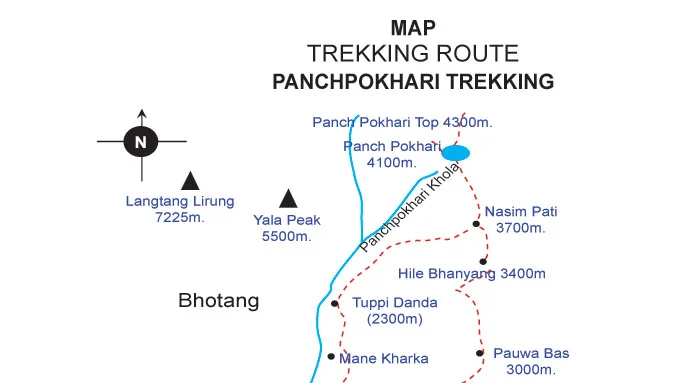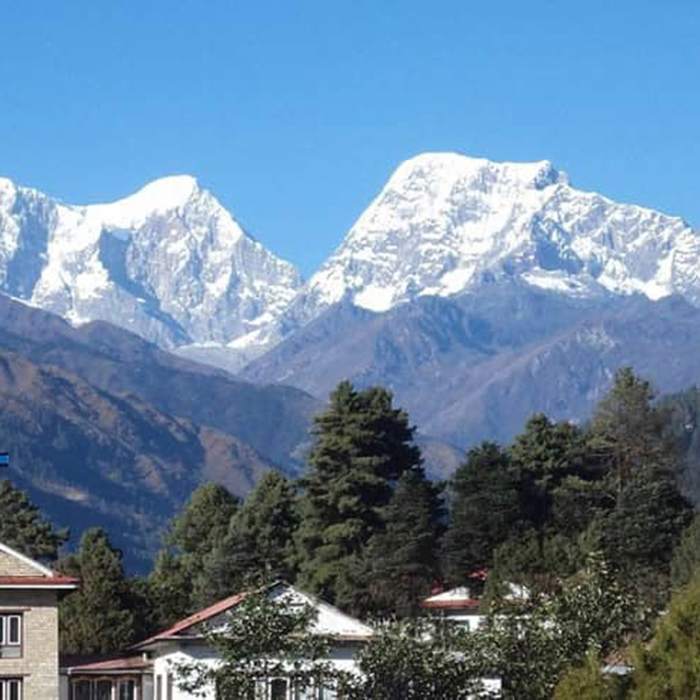Situated in the captivating Langtang region of Nepal, the Panch Pokhari Trek stands as an enticing option for both seasoned and aspiring trekkers, offering a harmonious blend of moderate challenge and breathtaking landscapes. This expedition has gained popularity among adventure enthusiasts seeking a rewarding trekking experience amidst stunning scenery and serene wilderness. Spanning over a span of 4 to 5 days, the Panch Pokhari Trek perfectly balances the thrill of a demanding trek with the allure of captivating natural vistas.
Traversing through the heart of the Langtang region, this trek unveils the region's abundant natural beauty while challenging trekkers with its moderate difficulty level. The journey unfurls through verdant forests, showcasing a mesmerizing diversity of flora and fauna. Ascending further, the trail reveals its alpine meadows adorned with a vibrant tapestry of rhododendrons, especially during the spring season. The pièce de résistance of this trek lies in the five sacred lakes, known as "Panch Pokhari," which hold immense religious significance for the local communities.
Main Highlights
Sacred Lakes of Panch Pokhari: The trek's centerpiece, the "Panch Pokhari" or five sacred lakes, holds immense spiritual significance for the local Sherpa and Tamang communities. Set against a backdrop of pristine Himalayan beauty, these lakes offer a serene and tranquil atmosphere that's perfect for reflection and awe.
Unspoiled Natural Beauty: The trail traverses through lush forests, enchanting alpine meadows, and rugged terrains, showcasing the diverse and untouched beauty of the Langtang region. The profusion of rhododendrons in spring adds a burst of color to the landscape, creating a feast for the eyes.
Cultural Immersion: Interact with the warm-hearted Sherpa and Tamang communities that inhabit the region. Their unique traditions, lifestyle, and hospitality offer a fascinating glimpse into the local way of life, providing cultural depth to your trekking experience.
Spectacular Mountain Views: Throughout the trek, you'll be treated to panoramic vistas of the Langtang and Jugal Himalayan ranges. The sight of towering peaks, snow-capped summits, and rolling hillsides creates an awe-inspiring backdrop that's a photographer's dream.
Moderate Trekking Challenge: The Panch Pokhari Trek strikes a balance between challenge and accessibility, making it suitable for trekkers with a moderate level of fitness. This allows both seasoned trekkers and those new to the trekking scene to enjoy the adventure and the stunning landscapes.
Trek Facts
- The Panch Pokhari Trek is a moderate trek in the Langtang National Park.
- The trek starts from the village of Syabrubesi and ends at the Panch Pokhari lakes, which are situated at an altitude of 4,100 meters above sea level.
- The trek takes 5-7 days to complete, depending on your fitness level.
- The best time to go on the Panch Pokhari Trek is during the spring (March-May) or autumn (September-November).
- The trail passes through forests of rhododendron, pine, and fir trees.
- Along the way, you will also see stunning views of the Jugal Himal, Rolwaling Himal, and Gauri Shankar mountains.
- The Panch Pokhari Trek is a great way to experience the beauty of the Nepal Himalayas and the culture of the Tamang people.
How can we make this trek more effective?
Experienced Guides: We provide knowledgeable and experienced trekking guides familiar with the Panch Pokhari route, local culture, and terrain that can greatly enhance the trekkers' experience. Our guides can ensure safety, offer insights, and facilitate cultural interactions.
Customizable Itineraries: We offer flexible itineraries that cater to different levels of fitness and time constraints allowing trekkers to choose a trek that suits their preferences, making the experience more inclusive and accommodating.
Acclimatization Strategy: We design itineraries with sufficient acclimatization days helps trekkers adapt to altitude and reduces the risk of altitude sickness, ensuring a safer and more enjoyable journey.
Cultural Immersion: We incorporate cultural experiences such as village homestays, local cuisine, and interactions with local communities that can provide you with a deeper understanding of the region's cultural heritage.
Well-Maintained Equipment: We provide reliable and well-maintained trekking equipment such as tents, sleeping bags, and hiking gear that can contribute to the comfort and safety of trekkers.
Environmental Sustainability: We promote responsible trekking practices, such as adhering to Leave No Trace principles and minimizing plastic waste which can help to preserve the pristine environment of the Panch Pokhari region.
Health and Safety Measures: Our company Prioritizes trekkers' safety by having emergency evacuation plans, first aid kits, and trained staff who are equipped to handle potential medical situations.
Communication: We maintain clear communication with trekkers about the trek's itinerary, expectations, and requirements before the journey which can help you to prepare adequately and ensure a smooth experience.
Best Season To Go Panch Pokhari Trek ?
The best time to go on the Panch Pokhari Trek is during the spring (March-May) or autumn (September-November).
During these seasons, the weather is mild and sunny, with clear views of the mountains. The trails are also dry and easy to walk on.
The monsoon season (June-August) can be wet and humid, and the trails can be muddy and slippery. The winter season (December-February) can be cold and snowy, and the trails can be icy.
Here is a more detailed breakdown of the weather conditions in each season:
Spring (March-May): This is the best time to go on the Panch Pokhari Trek. The weather is warm and sunny, with clear views of the mountains. The trails are also dry and easy to walk on. This is also the time of year when the rhododendrons are in bloom, adding even more beauty to the trek.
Autumn (September-November): The weather is still mild and sunny during this season, with clear views of the mountains. The trails are also dry and easy to walk on. This is also a good time to go on the trek, as there are fewer tourists than in the spring.
Monsoon (June-August): The monsoon season can be wet and humid, with heavy rainfall. The trails can be muddy and slippery, and there is a risk of landslides. It is not recommended to go on the Panch Pokhari Trek during this season.
Winter (December-February): The winter season can be cold and snowy, with temperatures dropping below freezing at night. The trails can be icy, and there is a risk of avalanches. It is not recommended to go on the Panch Pokhari Trek during this season unless you are experienced in winter trekking.
Ultimately, the best time to go on the Panch Pokhari Trek depends on your personal preferences and what you are looking for in a trekking experience. If you want mild weather and clear views of the mountains, then spring or autumn are the best seasons to go. If you are looking for a more challenging trek, then you may want to consider going in the winter.
How Expensive Is Panch Pokhari Trek ?
Here is a breakdown of some of the costs you can expect to incur on the Panch Pokhari Trek:
Accommodation: You will most likely be staying in basic guest houses or lodges on the trek. Expect to pay between $10 and $20 per night for a dorm bed, or $20 to $30 per night for a private room.
Food: You will be eating three meals a day on the trek, which will be cooked by your guide or porters. Expect to pay between $10 and $15 per day for food.
Guide and porters: You will need to hire a guide and porters to help you with the trek. The cost of a guide will vary depending on their experience, but you can expect to pay around $200 per day for a guide. The cost of a porter will vary depending on their weight carrying capacity, but you can expect to pay around $100 per day for a porter.
Transportation: You will need to be transported to and from the start and end of the trek. This can be done by bus, jeep, or private vehicle. The cost of transportation will vary depending on the mode of transportation you choose.
Permits and fees: You will need to purchase a trekking permit and a TIMS card before you start the trek. The cost of these permits will vary depending on your nationality.



.webp)


 5 Days
5 Days Moderate
Moderate 


1. LmMqtzme (3137 Laguna Street)
2025-05-22 13:28:23
testing@example.com